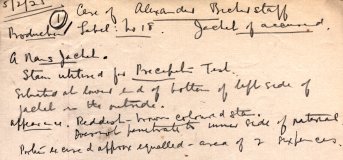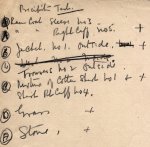The Medico-Legal Application of the Serological or Precipitin (Blood) Test
In 1897, Rudolf Kraus introduced the fluid precipitin test. He took bacterial filtrates, which he injected into rabbits. He later took the serum containing the antibodies (the precipitin) and incubated it with the bacterial filtrates (the antigen) and got a precipitation reaction (AbAg reaction).
From there, investigators use the precipitin test to determine whether the blood is of animal or human origin. In 1901 the German biologist, Paul Uhlenhuth (see bibliography) discovered that if he injected protein from a chicken egg into a rabbit, and then mixed serum from the rabbit with egg white, the egg proteins separated from the liquid to form a cloudy substance known as precipitin. In other words, it forms an antibody. In the forensic test for human blood, either a sample of the suspect blood is put into a test tube over the rabbit serum or it's used in the "gel diffusion" test, where it's placed in gel on a glass slide next to a sample of the reagent (anti-human serum). Passing an electric current through the glass, the protein molecules filter into the gelatin and toward each other. If a line forms where they meet - called a precipitin line - that means the sample is human blood.
Subsequently, George Nuttall working in Cambridge discovered that groups of related animals could produce varying amounts of precipitate in the rabbits antiserum. Therefore, further tests were required to eliminate this problem.
Glaisters and the Precipitin Test
John Glaister Senior utilized several chemical tests, including the Precipitin Test in order to identify mammalian blood. Fresh stains could be examined microscopically for blood corpuscles. Dry stains, however were soaked in saline solution, producing haemin crystals which were visible under the microscope. The spectroscopic test was employed to verify the age of a bloodstain.
In the third edition of John Glaister Senior's Text-Book of Medical Jurisprudence and Toxicology published in 1915 he noted that:
From a large experience in the examination of stains of blood for medico-legal purposes, it should be impressed on the student that it is in but rare cases that the foregoing texts can be carried out in their entirety. In very many cases the only scheme of examination which is possible, by reason of the minute amounts of material to be examined is as follows in outline
- 'Physical Examination by naked eye and hand lens in suitable light for physical characteristics of stain, as shape, matting of fibres of fabric, relation of one stain to another, etc.;
- Solution of the staining material in glycerine-water solution, or normal saline;
- Microscopic Examination of Solution obtained for corpuscles, noting their form if present and the presence and absence of nuclei;
- If corpuscles of mammalian type are obtained, then Schönbein's Test may be used, because now this text becomes a positive test;
- Formation of Haemin crystals (Teichmann's Test)
- Spectroscopic Test;
- Precipitin Test, if amount of material permits.'
Glaister Senior used the Precipitin Test to support his evidence in some of Glasgow's most notorious trials including Oscar Slater (1908-1909), William and Helen Harkness (1922) and the murder of Norrh Mohammed (1925). In many of these trials however, the test was used as supporting evidence, rather than crucial evidence. (See details of the case against Alexander Bickerstaff and Robert Handley below). By the 1930s many courts were accepting the precipitin test as standard practice.
Some years later, John Glaister Junior made a special study of the forensic applications of the precipitin test for his MD thesis submitted to the University of Glasgow in 1926. He concentrated on making the test more accurate, and on methods of identifying blood stains at various stages in very small quantities.
Case File GUA FM/2B/11
Alexander Bickerstaff was tried at the High Court of Judiciary in Edinburgh, January 1926. He was found guilty of indecent assault and sentenced to four years' penal servitude.
On 6th February, 1924, John Glaister senior produced a report at the request of Archibald Esquire, Procurator Fiscal of the County of Stirling. Glaister received, from Detective-Sergeant John Cowie the following productions: 1. Jacket, 2. Trousers, 3. Vest. Each item was tested for blood, using the precipitin test.
 |
Glaister's description of a stain of Bickerstaff's jacket Ref: GUA FM/2B/11 In his final report Glaister records that 'a portion of the stain situated at the lower end of the left side of the jacket was excised. This stain is of reddish-brown colour, but the staining does not penetrate the inner side of the material. The portion excised approximately equaled in area the size of two sixpences.' In his report, dated 6th February, 1925, Glaister recorded that 'solution from the stain on the Jacket gave a definite positive reaction that the blood thereon was also that from a human being'. |
Case File GUA FM 2B/19
Robert Handley was found guilty of rape and culpable homicide and sentenced to 15 years penal servitude in 1926. John Glaister, Senior examined a total of nine productions. In his analysis he found that on Production 1, a rain coat sleeve, after stains number 3 and 5 were excised and 'treated suitably and examined microscopically and chemically' that 'each was composed of mammalian blood, in order to establish the character of the mammalian blood in these stains, the Precipitin test was used in the case of Stain No. 5 on the Right Cuff, and the result showed that the blood was human blood.'
 |
Ref: GUA FM/2B/19 Raincoat sleeve, no. 3, mammalian blood Raincoat, right cuff, no.5, human blood Jacket, no. 1. outside, human blood Trousers, no. 2, outside, mammalian blood Portion of cotton shirt no. 1, human blood Portion of shirt. Rt. cuff no. 4, human blood |
Bibliography
- Glaister, J., Senior (1915) A Text-Book of Medical Jurisprudence and Toxicology (Edinburgh: E.& S. Livingstone)
- Glaister, J., Junior (1926) 'The Results of Experimental Work upon the Serological or Precipitin Test for the Detection of Blood, Considered from the Medico-Legal Aspect', M.D. Thesis, Special Collections, University of Glasgow
- Nuttall, GHF (1904) Blood Immunity and Blood Relationship-A Demonstration of Certain Blood-Relationships Amongst Animals by Means of the Precipitin Test for Blood [including original researches by GS Graham Smith and TSP Strangeways] (Cambridge: Cambridge University Press)
- Welch, WH & Nutall, GHF (1892) 'A Gas-Producing Bacillus (Bacillus Aërgenes Capsulatus Nov. Spec.) Capable of Rapid Development in the Blood-Vessels after Death', John Hopkins Hospital Bulletin, 3: 81-91.

